The serpentine stitch, a captivating embroidery technique, derives its name from its sinuous, winding pattern reminiscent of a serpent’s path.
This decorative stitch, a favorite among textile artists and embroiderers, weaves a distinctive, undulating design onto fabric. It can transform ordinary textiles into eye-catching masterpieces.
The process involves using a threaded needle to create a sequence of curving stitches that overlap, forming a meandering trail akin to a snake’s movement.
Serpentine stitches are prized for their versatility, allowing for endless variations in design and color combinations.
Whether adorning clothing, home decor, or quilts, this stitch adds a touch of artistry and elegance to any textile project.
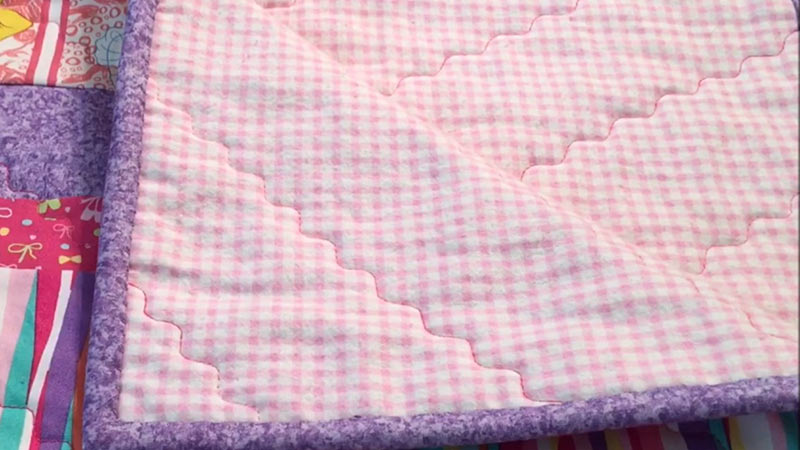
What Is Serpentine Stitch? -The Definition
Serpentine stitch, often referred to as a “snake” or “wavy” stitch, is a decorative sewing technique used in embroidery and sewing to create sinuous, undulating lines or patterns.
This stitch gets its name from its resemblance to the winding movements of a snake. It’s a versatile and visually appealing stitch that can add texture and dimension to fabric, making it popular for embellishing garments, quilts, and various craft projects.
To create a serpentine stitch, a sewing machine with this specific stitch option is typically used. The machine sews a continuous line of S-shaped or wave-like stitches, with the spacing and width of the waves adjustable according to the user’s preferences.
This stitch is commonly used for adding decorative borders, edging, or surface embellishments. Its flowing, curvaceous design makes it suitable for both simple and intricate designs, allowing crafters and sewers to explore their creativity and add a unique touch to their projects.
Serpentine stitch is a fantastic addition to any seamstress’s or embroiderer’s repertoire, offering endless possibilities for artistic expression.
Characteristics of Serpentine Stitch

Serpentine stitch is a decorative sewing technique with distinct characteristics that make it a versatile and attractive option for various sewing and embroidery projects.
Here are the key characteristics of Serpentine Stitch:
Versatility
The serpentine stitch is incredibly versatile and can be used in various embroidery projects. Whether you’re working on a decorative pillow, clothing, quilt, or any textile, this stitch can be adapted to suit your design needs.
Wavy Pattern
The primary characteristic of the serpentine stitch is its wavy, undulating pattern. It can be stitched in various sizes and styles, allowing you to create both bold, pronounced waves and delicate, subtle curves.
Texture and Dimension
When executed well, the serpentine stitch adds depth and texture to your embroidery. It can be used to mimic the look of natural elements like water, vines, or clouds, making it a valuable tool for creating realistic and visually interesting designs.
Ease of Execution
One of the serpentine stitch’s key advantages is its simplicity. Whether you’re a novice embroiderer or a seasoned pro, it’s relatively easy to learn and master. This makes it an excellent stitch for those looking to enhance their embroidery skills.
Varied Thread and Color Options
Serpentine stitches can be worked in a single color or a combination of contrasting or complementary colors. This adaptability allows for creative expression and customization to match the project’s style.
Fill or Border
Depending on your artistic vision, you can use serpentine stitches to fill large areas with texture or create decorative borders. This versatility allows you to use it for both functional and ornamental purposes.
Machine and Hand Embroidery
The serpentine stitch can be executed using various embroidery techniques. For those who prefer the precision of machine embroidery, modern sewing machines often include a built-in serpentine stitch setting.
Hand embroiderers, on the other hand, can achieve beautiful results using a simple needle and thread.
Types of Serpentine Stitch
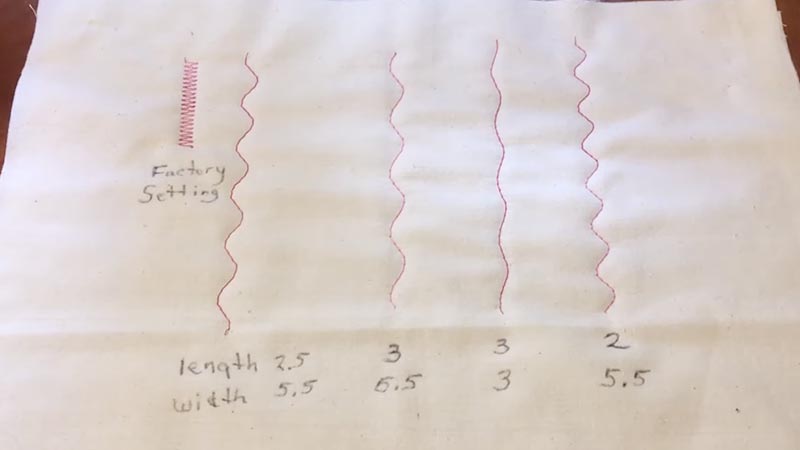
Serpentine stitch is a versatile decorative stitch that comes in various types, each with its unique characteristics and applications.
These different types of serpentine stitches provide sewers and embroiderers with a wide range of creative options.
Here are the common types of serpentine stitches:
Basic Serpentine Stitch
The standard serpentine stitch is characterized by its wavy, undulating pattern. It is adjustable in terms of width and length, allowing for customization based on the desired decorative effect. This type of serpentine stitch is versatile and suitable for many applications.
Multi-Step Serpentine Stitch
This variation of the serpentine stitch involves multiple waves in one pass. It creates a more intricate, layered appearance, making it a popular choice for adding texture and dimension to fabric.
Serpentine Zigzag Stitch
Combining the wavy characteristics of the serpentine stitch with the structure of a traditional zigzag stitch, the serpentine zigzag provides a unique decorative option. It’s great for adding a playful and dynamic touch to fabric surfaces.
Variable Width Serpentine Stitch
This type of serpentine stitch allows for changing the width of the waves during the sewing process. It’s particularly useful for creating designs that transition between narrow and wide sections.
Decorative Serpentine Stitches
Some sewing machines offer specialized serpentine stitches with decorative variations. These may include serpentine stitches with added embellishments, such as beads, sequins, or built-in patterns, further enhancing the decorative potential of this stitch.
Serpentine Embroidery Stitches
In the realm of machine embroidery, serpentine stitches can be adapted for embroidery purposes.
They may be used to create intricate, continuous designs, often as a background or fill stitch, adding elegance and detail to embroidered motifs.
Reverse Serpentine Stitch
In this variation, the waves of the serpentine stitch are inverted or run in the opposite direction.
This can create a striking visual contrast, making it a valuable choice for designs that require variation and creativity.
Serpentine Satin Stitch
By combining serpentine and satin stitches, you can create a luxurious and textured appearance. This is often used for adding embellishments to formal wear, home decor, or special occasion garments.
Serpentine Appliqué Stitch
This type of serpentine stitch is utilized for securing fabric appliqués in place. The undulating pattern provides a secure attachment while simultaneously adding an element of decoration to the appliqué.
Serpentine Hemstitch
Serpentine stitches can be used for creating decorative hemstitches, adding a touch of sophistication to the edges of napkins, tablecloths, and other linens.
What Is Serpentine Stitch Used For?
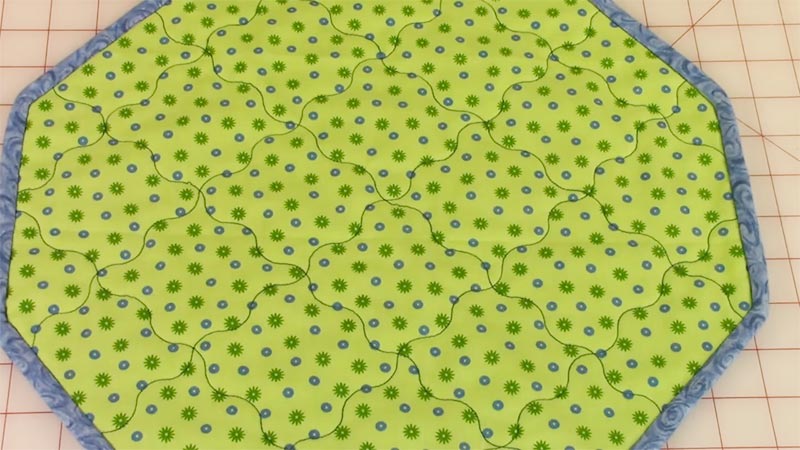
Serpentine stitch is a versatile sewing technique that finds numerous applications in both functional and decorative aspects of sewing and embroidery.
Here are the primary uses for serpentine stitch:
Decorative Stitching
One of the most common and prominent uses of serpentine stitch is for decorative purposes. It adds an aesthetic touch to fabric by creating a continuous, wavy line or pattern. This can enhance the visual appeal of various items, such as clothing, home decor, and accessories.
Edging and Borders
Serpentine stitch is frequently employed to create decorative edges and borders on garments, tablecloths, napkins, and other fabric items.
The undulating pattern adds a unique and elegant border that can elevate the overall look of the piece.
Embellishments
The flowing and sinuous nature of serpentine stitches makes them ideal for embellishing fabrics. This can include adding texture and dimension to items like quilts, throw pillows, and wall hangings.
Hemming
Serpentine stitch can be used to hem garments and fabric items. It softens the appearance of hems by providing a decorative touch, making it a suitable choice for skirts, dresses, and curtains.
Seam Reinforcement
While not its primary function, serpentine stitch can be utilized to reinforce seams, especially when a decorative element is desired along with strength. It can secure seams on items that experience wear and tear, like bags or backpacks.
Appliqué Attachment
When attaching fabric appliqués, the serpentine stitch is often chosen for securing the appliqué to the base fabric. It not only provides a strong hold but also contributes to the overall design.
Textured Backgrounds
In machine embroidery, serpentine stitches can be used as background or fill stitches. This creates a textured, continuous pattern behind more intricate designs, adding depth and interest to the embroidered motif.
Custom Fabric Designs
Advanced sewers and crafters use serpentine stitches to create their own custom fabric designs. By experimenting with various stitch widths and lengths, they can develop unique patterns and textures that suit their specific project.
Formal and Special Occasion Wear
Serpentine stitch is a popular choice for formal attire, such as wedding gowns and evening dresses. Its decorative and fluid nature complements the elegance of these garments.
Quilting
In quilting, serpentine stitch is employed to secure layers of fabric, batting, and backing together. Its meandering pattern is an attractive alternative to traditional quilting lines, giving quilts a distinctive appearance.
What Is Serpentine Stitch in Quilting?
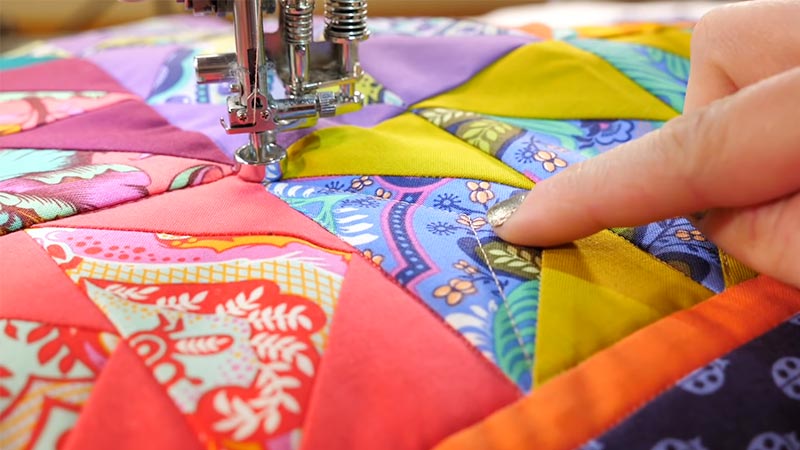
In quilting, a serpentine stitch refers to a specific type of decorative machine stitching pattern used to secure the layers of a quilt together.
This stitch creates a meandering, undulating, or serpentine-like pattern as it sews through the quilt sandwich, which typically consists of the quilt top, batting, and backing fabric.
Here’s what you need to know about the serpentine stitch in quilting:
Decorative Quilting
The primary purpose of the serpentine stitch in quilting is to add decorative quilting to the surface of the quilt.
Unlike traditional straight-line or grid quilting, the serpentine stitch creates a fluid, continuous design that can add texture, visual interest, and a sense of movement to the quilt.
Texture and Dimension
The meandering nature of the serpentine stitch provides a soft and organic texture to the quilt top. This can be especially appealing in quilts that aim for a more relaxed, casual, or contemporary look.
Ease of Execution
The serpentine stitch is often preferred by quilters for its ease of execution. It doesn’t require the precise marking or alignment that some other quilting patterns do. This makes it suitable for quilters of all skill levels, including beginners.
Versatility
Quilters can adjust the width and length of the serpentine stitch to achieve different visual effects. Narrower waves create a more delicate appearance, while wider waves result in bolder quilting lines.
Stitch Variations
Some sewing machines offer variations of the serpentine stitch, such as a double or triple serpentine stitch. These variations can create more intricate and layered designs, adding depth to the quilting.
Binding and Framing
Quilters often use the serpentine stitch to secure the quilt’s layers near the edges, serving as both a decorative border and a practical means of attaching the binding.
Quilt Durability
While the primary purpose of the serpentine stitch is decorative, it also helps secure the layers of the quilt, providing durability and preventing shifting or separation of the quilt top, batting, and backing.
What Is Serpentine Stitch in Sewing?
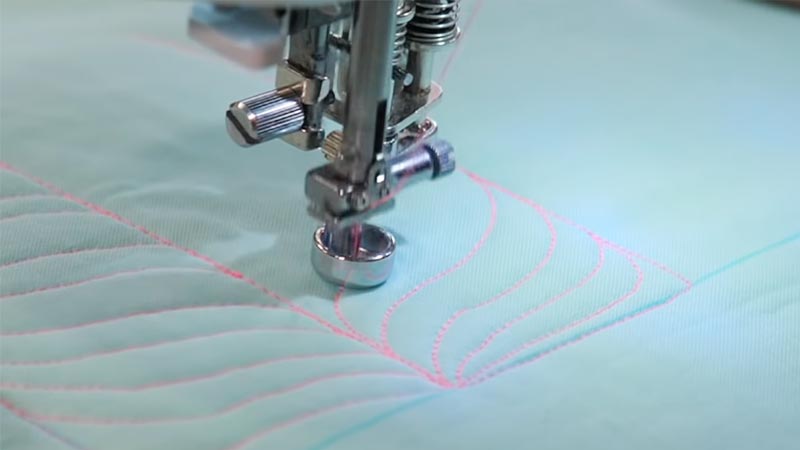
In sewing, a serpentine stitch sometimes referred to as a wavy stitch or snake stitch, is a decorative stitch pattern created by a sewing machine. The serpentine stitch features a continuous, undulating, and wavy design.
Here’s what is a serpentine stitch in sewing:
Decorative Embellishment
The primary purpose of the serpentine stitch in sewing is to add decorative embellishments to the fabric. It enhances the visual appeal of a wide range of sewing projects by creating a flowing, meandering pattern.
Versatility
Sewers can adjust the width and length of the serpentine stitch according to their preferences and the requirements of the project. This flexibility allows for a broad spectrum of decorative possibilities.
Edging and Borders
Serpentine stitch is often used to create decorative edging and borders on garments, home textiles (like tablecloths and napkins), and accessories. The wavy pattern adds an elegant and eye-catching finish to the fabric edges.
Hemming
The serpentine stitch is employed for hemming clothing items and fabric accessories. It not only secures the fabric edge but also provides a soft, decorative appearance to the hem.
Appliqué Attachment
When attaching fabric appliqués to a base fabric, the serpentine stitch is a popular choice. It effectively secures the appliqué while contributing to the overall design.
Embellishing Quilts
Quilters often use serpentine stitch for adding decorative quilting to their quilted projects. The undulating pattern creates visual interest and texture on the quilt top.
Reinforcing Seams
Although primarily decorative, serpentine stitch can also be used to reinforce seams, offering both strength and an artistic element to the stitching.
Custom Fabric Design
Advanced sewers can experiment with serpentine stitches to create their own unique fabric designs. By varying the width and length of the stitch, they can produce custom patterns for their projects.
Special Occasion and Formal Wear
Serpentine stitch is a popular choice for special occasions and formal wear, such as wedding dresses and evening gowns. Its decorative appearance adds elegance to these garments.
Creative Embroidery
In machine embroidery, serpentine stitch can be adapted for decorative embroidery work. It can be used as a background or fill stitch, creating a textured and continuous pattern behind more intricate designs.
What Does a Serpentine Stitch Look Like?

A serpentine stitch, as the name suggests, has a distinct, meandering, and wavy appearance. It looks like a continuous series of curved or sinuous lines that resemble the winding and flowing movements of a snake.
Here’s a description of what a serpentine stitch typically looks like:
Undulating Pattern
The most prominent feature of a serpentine stitch is its undulating or serpentine pattern. The stitch creates a continuous line that curves and winds in a gentle, flowing manner.
Wavy Waves
The serpentine stitch consists of waves or curves that are interconnected. These waves vary in width and spacing, depending on the settings chosen by the sewer. The result is a design that can be as narrow or as broad as desired.
Continuous and Seamless
The serpentine stitch is executed in a continuous and seamless manner, without any breaks or interruptions. This creates a smooth and flowing appearance on the fabric.
Aesthetic Versatility
The stitch width and length can be adjusted on a sewing machine, allowing for a range of aesthetic possibilities.
Narrow waves can create a delicate and subtle effect, while wider waves make a bolder and more pronounced statement.
Soft and Organic Look
The serpentine stitch imparts a soft and organic look to the fabric, making it an attractive choice for adding a touch of elegance and dimension to sewing and embroidery projects.
Varied Textures
Depending on the sewing machine settings and the chosen thread, a serpentine stitch can produce a variety of textures. For example, using decorative or metallic threads can add an extra layer of visual interest.
Continuous Flow
The beauty of the serpentine stitch lies in its continuous and flowing design, which can resemble the graceful lines found in nature. It provides a unique and eye-catching decorative element to fabric and textiles.
FAQS
Is the serpentine stitch reversible?
Yes, the serpentine stitch can be used on both sides of the fabric. The pattern will be visible on the fabric’s right side, but it can also create a subtle texture on the reverse side.
Can you use serpentine stitch for free-motion quilting?
Absolutely, serpentine stitching can be adapted for free-motion quilting, allowing quilters to create intricate, flowing designs on their quilts.
What type of needle is recommended for serpentine stitching with metallic threads?
When using metallic threads for serpentine stitching, it’s advisable to use a needle specifically designed for metallic thread embroidery to prevent thread breakage and ensure smooth stitching.
Can serpentine stitch be used to repair torn fabric or seams?
While it’s primarily a decorative stitch, a serpentine stitch can be used to repair small tears or seams when coupled with the right reinforcement techniques.
Are there specialty presser feet for achieving unique effects with serpentine stitch?
Yes, some sewing machines offer presser feet with guides that can help create distinctive effects with the serpentine stitch, such as variations in wave width or alignment.
Wrap Up
The serpentine stitch is a remarkable sewing technique that adds both aesthetic charm and functional versatility to a wide array of projects.
Its sinuous and undulating pattern, resembling the graceful movement of a snake, provides a unique and decorative touch to fabric surfaces.
Whether used for edging, hemming, quilting, appliqué attachment, or embroidery, the serpentine stitch offers boundless creative possibilities.
Its adaptability and ease of use make it accessible to sewers of all skill levels, while its ability to soften seams and enhance the visual appeal of fabric items continues to make it a favorite choice for those seeking to infuse their creations with elegance and artistry.
Leave a Reply